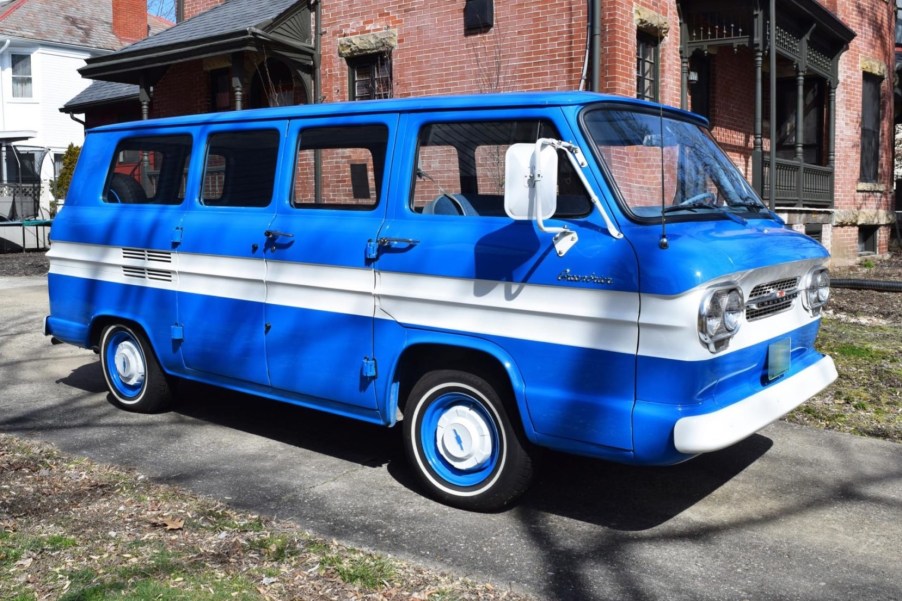
The Chevrolet Corvair Greenbrier Was GM’s VW Bus
Although you don’t necessarily need a van for overlanding or on-the-road living, some of them are quite capable both on- and off-pavement. From Japan, there’s the Mitsubishi Delica, for one. But arguably the progenitor of the #vanlife movement is the VW Vanagon, and its predecessor, the VW Bus (‘Microbus’). However, back in the 60s, the Microbus had some competition from GM in the form of the Chevrolet Corvair Greenbrier. And in some ways, Chevy had the superior product.
What was the Chevrolet Corvair Greenbrier?
The ‘Corvair’ in the Greenbrier’s full name may ring a bell. The Corvair was Chevrolet’s response to the original Beetle. Like the VW, it had a rear-engine, only it’s was a flat-six, like a Porsche 911. Unfortunately, GM’s infamous cost-cutting measures and subsequent Corvair accidents meant the car’s success was brief. But before the Corvair went away, it served as the basis for a number of other vehicles.

In addition to the sporty turbocharged Monza coupe, Chevrolet made a Corvair-based pickup, the rear-engine Corvair 95. There was even a version of the latter with a ramp built into the sides of the bed for easy loading.

Chevrolet also made a panel van version of the 95, the so-called ‘Corvan’, Bring a Trailer reports. And from that van came the Chevrolet Corvair Greenbrier camper. The Greenbrier was just one of several camper vans introduced by the Big Three in the early 60s. However, it had some notable advantages.
The rear-engine design cut down on heat leaking into the cabin as well as steering effort. It also meant the rear-wheel drive Corvair camper had better traction. And because the engine was air-cooled, it was cheaper and easier to repair.

As with the L300 Delica, the Greenbrier was cab-forward, placing the driver controls ahead of the front axle. That meant there was more room for people and cargo. And, because there was no driveshaft going front-to-back, the floor could be lower and flatter, further increasing space.
Chevrolet Corvair Greenbrier vs. VW Bus

As Motor Trend describes, the original Corvair was meant to take everything Volkswagen offered with the Beetle, but tailor it for American customers. The Corvair Greenbrier was essentially the same thing, only for the VW Bus.
Like the VW Bus, the Corvair Greenbrier offered 3 rows of seats. And, just like the Westfalia, the Greenbrier could be turned into a proper camper. GM offered a catalog of parts, including plywood cabinetry, a sink, icebox, a bed, fold-out tables, a roof-top tent, and various other accouterments. However, MT reports that even after being used for over 50 years, the Corvair Greenbrier rattles significantly less than the VW Bus.

The Greenbrier was also more powerful than the VW Bus. Originally, the Greenbrier came with an 80-hp engine. But, in 1964, that was upgraded to 95 hp, with an option to go up to 110 hp. At the time, the biggest engine the VW Bus offered produced only 52 hp. In addition to the more-usable cruising power, MT reports the Corvair camper also had a better transmission.
Pricing
Non-camper versions of the Corvair Greenbrier are priced fairly close to the lower ranges of non-Westfalia VW Buses. For example, a Greenbrier recently went for $19,000 on Bring a Trailer, while a VW Bus went for $18,500. However, late-60s Westfalia VW Buses have been known to fetch closer to $25,000-$30,000.
Original Corvair Greenbrier campers are somewhat rarer, but they’re also not as expensive. A slightly rusty example sold on BaT in 2015 for $9,900. And a better-condition one sold at the 2013 Monterey Auction for $9000.
Follow more updates from MotorBiscuit on our Facebook page.


